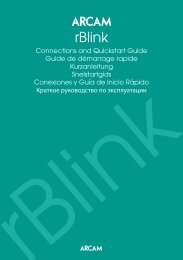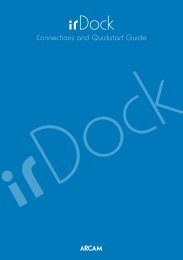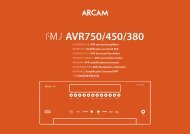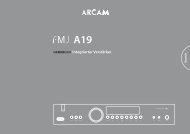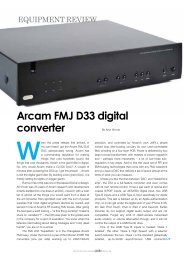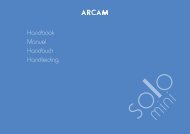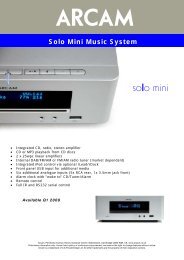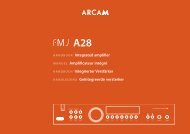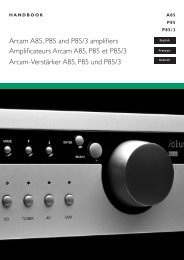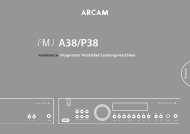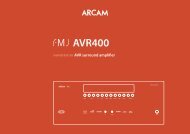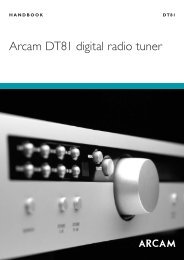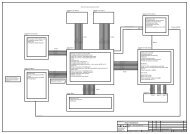Serial programming interface for Arcam DT91 digital tuner
Serial programming interface for Arcam DT91 digital tuner
Serial programming interface for Arcam DT91 digital tuner
You also want an ePaper? Increase the reach of your titles
YUMPU automatically turns print PDFs into web optimized ePapers that Google loves.
Custom Installation Notes:<br />
<strong>Serial</strong> <strong>programming</strong> <strong>interface</strong> <strong>for</strong><br />
<strong>Arcam</strong> <strong>DT91</strong> <strong>digital</strong> <strong>tuner</strong><br />
Model covered:<br />
DiVA <strong>DT91</strong>
<strong>DT91</strong><br />
(RS232)<br />
2<br />
Contents<br />
Applicability<br />
Applicability .......................................................... 2<br />
Controlling <strong>Arcam</strong> <strong>DT91</strong> via RS232 ....................... 3<br />
<strong>Serial</strong> cable specification ...................................... 3<br />
Command and response <strong>for</strong>mats .......................... 3<br />
Command specifications........................................ 4<br />
Power ............................................................... 4<br />
Source selection ................................................. 4<br />
Display brightness .............................................. 4<br />
Display in<strong>for</strong>mation type ...................................... 5<br />
Radio station in<strong>for</strong>mation ..................................... 5<br />
FM frequency selection ........................................ 6<br />
Station selection ................................................. 6<br />
Radio programme type ........................................ 6<br />
Request RDS/DLS in<strong>for</strong>mation .............................. 7<br />
Protocol version .................................................. 7<br />
Store a preset (v≥1.2)........................................ 8<br />
Preset selection (v≥1.2)...................................... 8<br />
DAB Scan/Erase (v≥1.2) ..................................... 8<br />
Set FM Stereo/Mono mode (v≥1.2) ....................... 9<br />
FM search (v≥1.2) ............................................. 9<br />
Publication reference<br />
This is <strong>Arcam</strong> technical publication SH178, issue 3 (July 2007).<br />
Equipment covered<br />
This publication describes the RS232 <strong>interface</strong> of the following <strong>Arcam</strong> ditial <strong>tuner</strong>s:<br />
Model Software version<br />
<strong>Arcam</strong> DiVA <strong>DT91</strong> All; Additional codes <strong>for</strong> version 1.2<br />
The latest version of this document is available on the <strong>Arcam</strong> Dealer extranet accessed via<br />
www.arcam.co.uk/extranet<br />
If you cannot yet access the Dealer extranet, please apply by email to nadinec@arcam.co.uk<br />
<strong>Arcam</strong>, Pembroke Avenue, Waterbeach, CAMBRIDGE, CB5 9QR, England<br />
+44 (0)1223 203200 www.arcam.co.uk/extranet
Controlling <strong>Arcam</strong> <strong>DT91</strong> via RS232<br />
This document describes the remote control protocol <strong>for</strong> controlling the <strong>Arcam</strong> DiVA <strong>DT91</strong> DAB Digital<br />
Tuners via the serial (RS232) <strong>interface</strong>.<br />
<strong>Serial</strong> cable specification<br />
The cable is wired as a null modem, i.e. pin 2=RX, pin 3=TX, pin 5=RS232 ground.<br />
Data transfer <strong>for</strong>mat<br />
< Transfer rate: 19,200bps.<br />
< 1 start bit, 8 data bits, 1 stop bit, no parity, no flow control.<br />
Conventions<br />
< The remote controller is referred to as the ‘RC’.<br />
< All values in this section are hexadecimal values, unless otherwise specified.<br />
Command and response <strong>for</strong>mats<br />
Communication between the RC and the <strong>DT91</strong> takes the <strong>for</strong>m of sequences of bytes, with all commands<br />
and responses having the same basic <strong>for</strong>mat. Communication between the two is full duplex. The <strong>DT91</strong><br />
shall always respond to a received command.<br />
Each transmission by the RC shall be at least five bytes long in the following <strong>for</strong>mat:<br />
<br />
< STR (Start transmission): 0x21<br />
< CC (Command code): the code <strong>for</strong> the command<br />
< DL (Data length): the number of data items following this item, excluding the ETR<br />
< Data: the parameters <strong>for</strong> the command<br />
< ETR (End transmission): 0xD<br />
Each response by the <strong>DT91</strong> shall be at least six bytes long in the following <strong>for</strong>mat:<br />
<br />
< STR (Start transmission): 0x21<br />
< RC (Reply code): = command code<br />
< AC (Answer code): answer code (see below)<br />
< DL (Data length): the number of data items following this item, excluding the ETR<br />
< Data: the in<strong>for</strong>mation associated with this response<br />
< ETR (End transmission): 0xD<br />
Note that the <strong>DT91</strong> shall transmit messages whenever its status changes.<br />
State changes as a result of other inputs<br />
It is possible that the state of the <strong>DT91</strong> may be changed as a result of user input via the front panel<br />
buttons or via the IR remote control. Changes resulting from these inputs shall be relayed to the RC<br />
(using the appropriate message type) as they occur.<br />
For example, if the user changed the front panel display brightness using the DISP button on the remote<br />
control, a display message (defined below) would be sent to the RC. A similar action would be taken <strong>for</strong><br />
all other state changes.<br />
Answer codes<br />
��<br />
��<br />
���<br />
� �<br />
� �<br />
The following answer codes are defined:<br />
< Command OK 0x1: The command has been accepted and processed completely.<br />
< Command Failed 0x0: The command has failed <strong>for</strong> some reason.<br />
<strong>Arcam</strong>, Pembroke Avenue, Waterbeach, CAMBRIDGE, CB5 9QR, England<br />
+44 (0)1223 203200 www.arcam.co.uk/extranet<br />
<strong>DT91</strong><br />
(RS232)<br />
3
Command specifications<br />
<strong>DT91</strong><br />
(RS232)<br />
4<br />
Power<br />
Change the stand-by state of the <strong>DT91</strong>.<br />
Example<br />
Command/response sequence to bring the <strong>DT91</strong> out of standby:<br />
Command: 0x21 0x00 0x01 0x01 0x0D<br />
Response: 0x21 0x00 0x01 0x01 0x01 0x0D<br />
Source selection<br />
Switch between DAB and FM.<br />
Example<br />
Command/response sequence to switch to FM:<br />
Command: 0x21 0x01 0x01 0x01 0x0D<br />
Response: 0x21 0x01 0x01 0x01 0x01 0x0D<br />
Display brightness<br />
Set the display brightness.<br />
Example<br />
Command/response sequence to dim the display one level, where the result is<br />
that the display brightness is at level 1:<br />
Command: 0x21 0x0A 0x01 0xF1 0x0D<br />
Response: 0x21 0x0A 0x01 0x01 0x01 0x0D<br />
<strong>Arcam</strong>, Pembroke Avenue, Waterbeach, CAMBRIDGE, CB5 9QR, England<br />
+44 (0)1223 203200 www.arcam.co.uk/extranet<br />
Command:<br />
Byte: Description:<br />
CC 0x00 (Command code)<br />
DL 0x01 (Data length)<br />
D1 0x00 – Enter stand-by state<br />
0x01 – Power-on<br />
0xF2 – Toggle power state<br />
0xF3 – Request power state<br />
Response:<br />
Byte: Description:<br />
RC 0x00 (Reply Code)<br />
AC Answer code<br />
DL 0x01 (Data length)<br />
D1 Response:<br />
0x00 – The <strong>DT91</strong> is in stand-by state<br />
0x01 – The <strong>DT91</strong> is powered on<br />
Command:<br />
Byte: Description:<br />
CC 0x01 (Command code)<br />
DL 0x01 (Data length)<br />
D1 0x01 – FM<br />
0x02 – DAB<br />
0xF3 – Request current source<br />
Response:<br />
Byte: Description:<br />
RC 0x01 (Reply Code)<br />
AC Answer code<br />
DL 0x01 (Data length)<br />
D1 Response:<br />
Source values as given above.<br />
Command:<br />
Byte: Description:<br />
CC 0x0A (Command code)<br />
DL 0x01 (Data length)<br />
D1 0xF0 – Increase the display brightness<br />
0xF1 – Decrease the display brightness<br />
0xF3 – Request current display brightness<br />
Response:<br />
Byte: Description:<br />
RC 0x0A (Reply Code)<br />
AC Answer code<br />
DL 0x01 (Data length)<br />
D1 Response:<br />
The new brightness level,<br />
0x00 (off) - 0x02 (full brightness).
Display in<strong>for</strong>mation type<br />
Set the display in<strong>for</strong>mation type.<br />
Example<br />
Command/response sequence to set the display text to show the programme<br />
type:<br />
Command: 0x21 0x0C 0x01 0x03 0x0D<br />
Response: 0x21 0x0C 0x01 0x01 0x03 0x0D<br />
Radio station in<strong>for</strong>mation<br />
Request in<strong>for</strong>mation on the current radio station.<br />
Example<br />
Command/response sequence to request the station frequency, where the<br />
source is FM and the frequency is 105.2MHz:<br />
Command: 0x21 0xDF 0x02 0xF3 0x00 0x0D<br />
Response: 0x21 0xDF 0x01 0x03 0x00 0x69 0x14 0x0D<br />
Example<br />
Command/response sequence to request the signal strength, where the<br />
current signal strength is 10:<br />
Command: 0x21 0xDF 0x02 0xF3 0x01 0x0D<br />
Response: 0x21 0xDF 0x01 0x03 0x01 0x0A 0x00 0x0D<br />
<strong>Arcam</strong>, Pembroke Avenue, Waterbeach, CAMBRIDGE, CB5 9QR, England<br />
+44 (0)1223 203200 www.arcam.co.uk/extranet<br />
Command:<br />
Byte: Description:<br />
CC 0x0C (Command code)<br />
DL 0x01 (Data length)<br />
D1 If the current source is FM:<br />
0x00 – Set the display to show frequency<br />
0x01 – Set the display to show sig. strength<br />
0x02 – Set the display to show RDS info.<br />
0x03 – Set the display to show prog. type<br />
Response:<br />
If the current source is DAB:<br />
0x00 – Set the display to show data rate<br />
0x01 – Set the display to show sig. strength<br />
0x02 – Set the display to show DLS info.<br />
0x03 – Set the display to show prog. type<br />
Byte: Description:<br />
RC 0x0C (Reply Code)<br />
AC Answer code<br />
DL 0x01 (Data length)<br />
D1 Response:<br />
The new display setting.<br />
Command:<br />
Byte: Description:<br />
CC 0xDF (Command code)<br />
DL 0x02 (Data length)<br />
D1 0xF3 – Request station in<strong>for</strong>mation<br />
D2 0x00 – Request the station frequency (FM<br />
only)<br />
0x01 – Request the station signal strength<br />
0x02 – Request the station MPEG mode<br />
0x04 – Request the station data rate<br />
Response:<br />
Byte: Description:<br />
RC 0xDF (Reply Code)<br />
AC Answer code<br />
DL 0x03 (Data length)<br />
D1 0x00 – Message contains station freq.<br />
0x01 – Message contains signal strength<br />
0x02 – Message contains MPEG mode<br />
0x04 – Message contains data rate<br />
D2 Response to the FM frequency request:<br />
MHz of current frequency<br />
Response to the DAB MPEG mode request:<br />
0x00 – Stereo<br />
0x01 – Joint stereo<br />
0x02 – Dual mono<br />
0x03 – Mono<br />
Response to the DAB data rate request:<br />
0x00 - 0xE0 (0 - 224kb/s) – data rate<br />
Response to the signal strength request:<br />
0x00 - 0x10 – signal strength<br />
D3 Response to the FM frequency request:<br />
kHz (*10) of current frequency<br />
Response to the DAB MPEG mode request:<br />
0x00<br />
Response to the DAB data rate request:<br />
0x00<br />
Response to the signal strength request:<br />
0x00<br />
<strong>DT91</strong><br />
(RS232)<br />
5
<strong>DT91</strong><br />
(RS232)<br />
6<br />
FM frequency selection<br />
Increment/decrement the FM frequency selection.<br />
Example<br />
Command/response sequence to decrement the station frequency, where the<br />
new frequency is 97.9MHz:<br />
Command: 0x21 0xE4 0x01 0xF1 0x0D<br />
Response: 0x21 0xE4 0x01 0x02 0x61 0x5A 0x0D<br />
Station selection<br />
Increment/decrement the DAB station selection.<br />
Example<br />
Command/response sequence to increment the DAB station selection, where<br />
the new station is called “DAB STATION 2”:<br />
Command: 0x21 0xDE 0x01 0xF0 0x0D<br />
Response: 0x21 0xDE 0x01 0x0D 0x44 0x41 0x42 0x20 0x53 0x54<br />
0x41 0x54 0x49 0x4F 0x4E 0x20 0x32 0x0D<br />
Radio programme type<br />
Request in<strong>for</strong>mation on the current station programme type.<br />
Example<br />
Command/response sequence to request the programme type, where the<br />
programme type is “POP MUSIC”:<br />
Command: 0x21 0xE6 0x01 0xF3 0x0D<br />
Response: 0x21 0xE6 0x01 0x09 0x50 0x4F 0x50 0x20 0x4D 0x55<br />
0x53 0x49 0x43 0x0D<br />
<strong>Arcam</strong>, Pembroke Avenue, Waterbeach, CAMBRIDGE, CB5 9QR, England<br />
+44 (0)1223 203200 www.arcam.co.uk/extranet<br />
Command:<br />
Byte: Description:<br />
CC 0xE4 (Command code)<br />
DL 0x01 (Data length)<br />
D1 0xF0 – Increment the tuned frequency<br />
0xF1 – Decrement the tuned frequency<br />
0xF3 – Request the current tuned frequency<br />
Response:<br />
Byte: Description:<br />
RC 0xE4 (Reply Code)<br />
AC Answer code<br />
DL 0x02 (Data length)<br />
D1 MHz of current frequency<br />
D2 kHz (*10) of current frequency<br />
Command:<br />
Byte: Description:<br />
CC 0xDE (Command code)<br />
DL 0x01 (Data length)<br />
D1 DAB only:<br />
0xF0 – Select the next DAB station<br />
0xF1 – Select the previous DAB station<br />
Response:<br />
Command:<br />
Byte: Description:<br />
CC 0xE6 (Command code)<br />
DL 0x01 (Data length)<br />
D1 0xF3 – Request programme type<br />
Response:<br />
DAB or FM:<br />
0xF3 – Request the current station name<br />
Byte: Description:<br />
RC 0xDE (Reply Code)<br />
AC Answer code<br />
DL (Data length)<br />
Dn Response:<br />
either: The service label of the radio<br />
station, in ASCII characters (DAB only)<br />
or: 0xFF Station unavailable (DAB only)<br />
Byte: Description:<br />
RC 0xE6 (Reply Code)<br />
AC Answer code<br />
DL (Data length)<br />
Dn Response:<br />
The programme type of the selected<br />
station, in ASCII characters
Request RDS/DLS in<strong>for</strong>mation<br />
Request RDS/DLS (FM/DAB) in<strong>for</strong>mation from the current radio station.<br />
Example<br />
Command/response sequence to request the RDS/DLS in<strong>for</strong>mation, where the<br />
in<strong>for</strong>mation is “Playing your favourite music”:<br />
Command: 0x21 0xE7 0x01 0xF3 0x0D<br />
Response: 0x21 0xE7 0x01 0x1C 0x50 0x6c 0x61 0x79 0x69 0x6E<br />
0x67 0x20 0x79 0x6F 0x75 0x72 0x20 0x66 0x61 0x76 0x6F 0x75<br />
0x72 0x69 0x74 0x65 0x20 0x6D 0x75 0x73 0x69 0x63 0x0D<br />
Protocol version<br />
Request the RS232 protocol version of the <strong>DT91</strong>.<br />
Example<br />
Command/response sequence to request the protocol version:<br />
Command: 0x21 0xED 0x01 0xF3 0x0D<br />
Response: 0x21 0xED 0x01 0x02 0x01 0x00 0x0D<br />
<strong>Arcam</strong>, Pembroke Avenue, Waterbeach, CAMBRIDGE, CB5 9QR, England<br />
+44 (0)1223 203200 www.arcam.co.uk/extranet<br />
Command:<br />
Byte: Description:<br />
CC 0xE7 (Command code)<br />
DL 0x01 (Data length)<br />
D1 0xF3 – Request RDS/DLS in<strong>for</strong>mation<br />
Response:<br />
Byte: Description:<br />
RC 0xE7 (Reply Code)<br />
AC Answer code<br />
DL (Data length)<br />
Dn Response:<br />
The RDS/DLS in<strong>for</strong>mation of the selected<br />
station, in ASCII characters. Up to 128<br />
characters may be returned.<br />
Command:<br />
Byte: Description:<br />
CC 0xED (Command code)<br />
DL 0x01 (Data length)<br />
D1 0xF3 – Request protocol version<br />
Response:<br />
Byte: Description:<br />
RC 0xED (Reply Code)<br />
AC Answer code<br />
DL 0x02 (Data length)<br />
D1 0x01 (Major revision)<br />
D2 (Minor revision)<br />
<strong>DT91</strong><br />
(RS232)<br />
7
<strong>DT91</strong><br />
(RS232)<br />
8<br />
The following commands have been added <strong>for</strong> version 1.2 of<br />
the protocol. They are not available in earlier versions.<br />
Store a preset (v≥1.2)<br />
Program the current station/frequency into one of the “preset” positions.<br />
Example<br />
Command/response sequence to programe the current station into preset 32:<br />
Command: 0x21 0xDC 0x01 0x20 0x0D<br />
Response: 0x21 0xDC 0x01 0x01 0x20 0x0D<br />
Preset selection (v≥1.2)<br />
Select a preset radio station.<br />
Example<br />
Command/response sequence to select preset 12:<br />
Command: 0x21 0x13 0x01 0x0C 0x0D<br />
Response: 0x21 0x13 0x01 0x01 0x0C 0x0D<br />
DAB Scan/Erase (v≥1.2)<br />
Erase the current DAB station list, or scan <strong>for</strong> new stations.<br />
Example<br />
Command/response sequence to trigger a scan <strong>for</strong> new DAB stations:<br />
Command: 0x21 0xDB 0x01 0x01 0x0D<br />
Response: 0x21 0xDB 0x01 0x01 0x01 0x0D<br />
<strong>Arcam</strong>, Pembroke Avenue, Waterbeach, CAMBRIDGE, CB5 9QR, England<br />
+44 (0)1223 203200 www.arcam.co.uk/extranet<br />
Command:<br />
Byte: Description:<br />
CC 0xDC (Command code)<br />
DL 0x01 (Data length)<br />
D1 0x1 - 0x64 – The selected preset.<br />
Response:<br />
Byte: Description:<br />
RC 0xDC (Reply Code)<br />
AC Answer code<br />
DL 0x1 (Data length)<br />
Dn Response:<br />
The selected preset.<br />
Command:<br />
Byte: Description:<br />
CC 0x13 (Command code)<br />
DL 0x01 (Data length)<br />
D1 0x1 - 0x64 – The selected preset.<br />
Response:<br />
Byte: Description:<br />
RC 0x13 (Reply Code)<br />
AC Answer code<br />
DL 0x1 (Data length)<br />
Dn Response:<br />
The selected preset.<br />
Command:<br />
Byte: Description:<br />
CC 0xDB (Command code)<br />
DL 0x01 (Data length)<br />
D1 0x0 – Erase the current station list.<br />
0x1 – Scan <strong>for</strong> new stations.<br />
0xf3 – Request current state<br />
Response:<br />
Byte: Description:<br />
RC 0xDB (Reply Code)<br />
AC Answer code<br />
DL 0x1 (Data length)<br />
D1 Response:<br />
0x0 – Not scanning <strong>for</strong> stations<br />
0x1 – Scanning <strong>for</strong> stations
SH178<br />
Issue 3<br />
Set FM Stereo/Mono mode (v≥1.2)<br />
Switch between stereo and mono mode <strong>for</strong> FM reception.<br />
Example<br />
Command/response sequence to query the current FM reception mode, where<br />
the unit is in stereo mode:<br />
Command: 0x21 0x11 0x01 0xF3 0x0D<br />
Response: 0x21 0x11 0x01 0x01 0x00 0x0D<br />
FM search (v≥1.2)<br />
Search <strong>for</strong> new FM stations.<br />
Example<br />
Command/response sequence to search <strong>for</strong> new stations, scanning up the<br />
frequency band:<br />
Command: 0x21 0xDA 0x01 0xF0 0x0D<br />
Response: 0x21 0xDA 0x01 0x01 0xF0 0x0D<br />
<strong>Arcam</strong>, Pembroke Avenue, Waterbeach, CAMBRIDGE, CB5 9QR, England<br />
+44 (0)1223 203200 www.arcam.co.uk/extranet<br />
Command:<br />
Byte: Description:<br />
CC 0x11 (Command code)<br />
DL 0x01 (Data length)<br />
D1 0x0 – Set stereo mode.<br />
0x1 – Set mono mode.<br />
0xf2 – Switch stereo/mono.<br />
0xf3 – Request current state.<br />
Response:<br />
Byte: Description:<br />
RC 0x11 (Reply Code)<br />
AC Answer code<br />
DL 0x1 (Data length)<br />
D1 Response:<br />
0x0 – Stereo mode.<br />
0x1 – Mono mode.<br />
Command:<br />
Byte: Description:<br />
CC 0xDA (Command code)<br />
DL 0x01 (Data length)<br />
D1 0xf0 – Search up from the current freq.<br />
0xf1 – Search down from the current freq.<br />
Response:<br />
Byte: Description:<br />
RC 0xDA (Reply Code)<br />
AC Answer code<br />
DL 0x1 (Data length)<br />
D1 Response:<br />
0xf0 – Searching up.<br />
0xf1 – Searching down.<br />
<strong>DT91</strong><br />
(RS232)<br />
9



